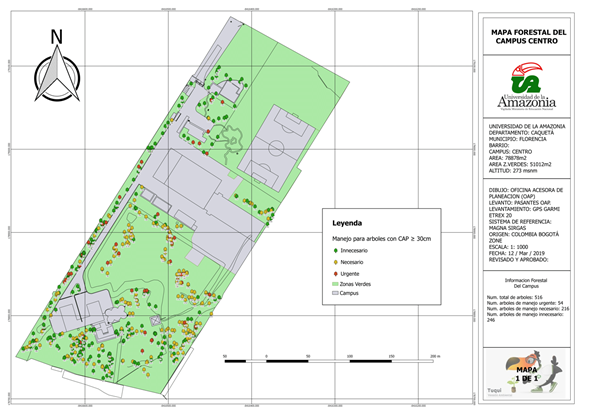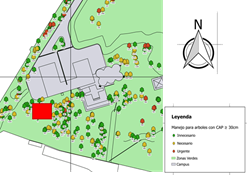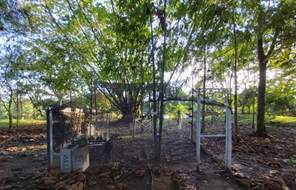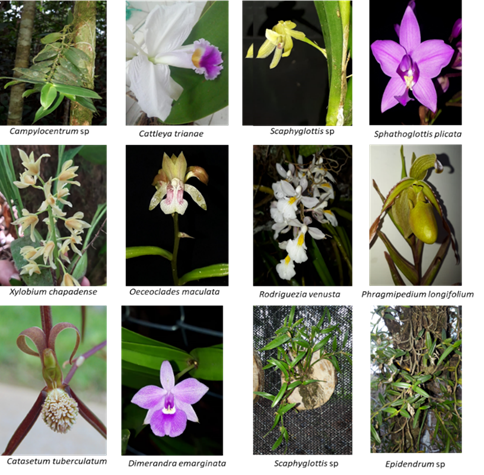eISSN: 2576-4462


Research Article Volume 7 Issue 2
Botanical Research Group, University of Amazonia, Colombia
Correspondence: Marco A. Correa Munera, Botanical Garden of the Universidad de la Amazonia JBUDLA, Botanical Research Group. University of Amazonia, Colombia
Received: March 17, 2023 | Published: May 19, 2023
Citation: Calderón SCA, Gasca TMJ, Correa MMA, et al. Orchids of the Uniamazonia Botanical Garden (JBUDLA). Horticult Int J. 2023;7(2):45-50. DOI: 10.15406/hij.2023.07.00274
The Uniamazonia Botanical Garden (JBUDLA), is located on the campus of the University of Amazonia in Florencia - Caquetá, in the botanical gardens is able to present spaces of great importance as they manage living collections of plants in urban areas generating a suitable environment. It is an ex situ collection that houses different collections of plants with native species of Colombia and other parts of the region. Among the objectives proposed for this work was the recovery of the collection of live orchid plants of the Uniamazonia Botanical Garden, in order to strengthen the special collections of the Uniamazonia Botanical Garden since it did not have this new collection of orchids called Orquideario, These orchids belong to the Orchidaceae family. Field trips, germplasm rescue and planting were carried out in order to enrich the collection with some genera such as Rodriguezia (70), Cattleya (20), Dichaea (40) and Oeceoclades (13).
Keywords: Collection. Colombia. Orchids. Inventory. Botanical Garden
The objective of herbariums is to preserve dry samples of plants that may be native or introduced, serving as scientific support or backup for the living collections of botanical gardens.1 Specimens of species that were collected in their natural habitat are stored in these places, which is why they are considered the main starting point for compiling primary information on the species, which later allows the determination of hotspots of diversity and the evaluation of their wild populations, thus promoting conservation strategies for these species, populations or ecosystems in which they are found.2
This work seeks to strengthen the living collections of the Uniamazonia Botanical Garden, increasing the information on the richness of orchids in the department and the region, in order to share and exchange knowledge.3
To assemble the living collection of orchids, field trips were made with the objective of rescuing germplasm, taking into account the georeferencing and taxonomic description of each of the individuals collected, pressed samples were left for later herbalization and live samples to be taken to the nursery for planting and finally the conformation of the living collection.4
Study area
The Uniamazonia Botanical Garden is located in the municipality of Florencia - Caquetá, has an annual rainfall of 3,840 mm, an annual temperature of 26 °C, and an altitude of 242 meters above sea level. It also has a humid tropical climate with a relative humidity of 80% throughout the year, not to mention that this municipality has clay and acidic soils.5 The JBUDLA is located in the Central Headquarters and has approximately four hectares between green areas that are composed of wild and cultivated plants; it is divided between the Herbarium Enrique Forero - HUAZ, where the dry collections are kept and the living collections that are part of the green areas of the campus, which is distributed in paths where they are generally characterized by taxonomic groups, where their vegetation cover varies due to anthropic activities carried out in previous years.6 Nevertheless, it represents one of the areas with the most vegetation within the urban area of the municipality of Florencia and is of great importance for the conservation of the species that inhabit it.7
Adequacy of physical space
The site for the location of the living collection of orchids was identified, which meets the necessary environmental conditions, a mesh house was built that functions as insulation that prevents the plants located within it from suffering any damage. The place was adequately taking into account the natural environmental conditions of the group to work, without affecting in any way the stability when working with the plants, it should be noted that environmental education is one of the main objectives of the Uniamazonia Botanical Garden.
Field registration
A standardized methodology was used for the rapid survey that provided us with representative information on the species, quantity and type of vegetation where sampling was carried out, since orchids were found in different environments.8 Inventory and monitoring methods were implemented. The objective was to address a large number of diverse species distributed in varied habitats. Most of them were found in the canopy and understory. During the field work, a record was kept of the orchids observed in the localities, the place where they were found, the georeferencing, the number of individuals observed, the growth habit, and their phenology were recorded.9
Photographic record
The photographic record was taken of each of the species that were found, taking pictures of the growth habit, flowers or inflorescences, images with which the species were identified with the help of illustrated guides and specialists from different places that met at the V Botanical Congress.
Germplasm collection
Germplasm collection and identification campaigns were carried out, and the necessary work such as planting and maintenance was done to conserve them in the special collection. The collection is intended for environmental education and conservation; therefore, the collected material was given the function that corresponded to its use. The complete individual or part of it was collected to guarantee the formation of other plants, this type of propagules is especially susceptible to dehydration, a situation that forced us to take extreme precautions in their handling and to minimize the time between their collection and use.10 The choice of the individuals that were collected was made by complying with some criteria, the main one being that the individual should be fertile, which facilitated its identification. In support of the living collection of orchids, a collection of herbarium specimens was made in order to have a representation of the plant biodiversity of this family that will allow scientific work to be carried out.
Format
The format used to record information on the collection of individuals in the field is part of the SIGC of the Uniamazonia Botanical Garden with code FO-A-APH-06-02, version 1. In this format, the date of entry of the plant, the person responsible and the identity of the plant or code were recorded.11 See Annex 1 & 2.
Location of the special orchid collection of the botanical garden of the University of amazonia
The special orchid collection is located in the Cycadal trail of the Amazon University Center campus, which is made up of 125 individuals distributed in 25 genera of 18 families such as: Arecaceae, Asteraceae, Bignoniaceae, Cycadaceae, Euphorbiaceae, Fabaceae, Lamiaceae, Lauraceae, Lecythidaceae, Malvaceae, Myrtaceae, Musaceae, Moraceae, Piperaceae, Rutaceae, Solanaceae, Strelitziaceae and Urticaceae within which the Fabaceae family is one of the most representative with 30 individuals distributed in 5 genera (Bauhinia, Erythrina, Inga, Pseudopiptadenia and Zygia). The name Cycadal, is due to the special collection of the order Cycadales; in which there are two families: Cycadaceae with one species (Cycas revolutans) and Zamiaceae with 5 species present (Zamia manicata, Zamia amazonum, Zamia melanorrhachis, Zamia obliqua, Zamia ulei that are in critical danger due to the destruction of their habitats and overexploitation as ornamental use. On the other hand, the presence of a large number of adult individuals of Erythrina ulei, an endemic species, can be appreciated, which are in good health.
The conditions of the trail are good for maintaining healthy orchid cultivation, since the trees mentioned above create a favorable and pleasant environment for the plants, which facilitates their maintenance, since they have access to the amount of water and light necessary for their good development; the adaptations that were made improve the quality of the space (Figure 1-2).

Figure 1 Cartographic map with forest information of the Uniamazonia Campus. (Taken from Trujillo-G., 2019).

Figure 2 Cartographic map with forest information of the Centro campus. (Taken from Trujillo-G., 2019).
Implementation of the environment in appropriate conditions for the cultivation of orchids in the Botanical Garden of the University of Amazonia
In order to establish the orchid collection, a special space was created to grow and interact with them. It was necessary to create a covered environment to prevent the plants from being removed from the university, the mesh house provides protection against animals that come from an invasion near the facilities of Universidad de la Amazonia. A poly-shade was installed on top to prevent the sun's rays from penetrating directly and burning the leaves of the orchids. The plants were organized by genus and each one was labeled with its respective scientific name and code to facilitate the identification of each one of them, as shown in Figure 3-4.

Figure 3 Final structure of the Special Orchid Collection of the Universidad de la Amazonia located on the Cycadal Trail.

Figure 4 Orchid species that are part of the new special collection of the Uniamazonia Botanical Garden.
The mesh house has a total area of 25 square meters and is made up of 4 polymeric or reinforced plastic posts of about two meters each that serve as support; a 19-meter wire mesh that encloses the area where the plants were located; In the upper part, a medium-caliber black polyshade was installed as an insulator or protection from direct sunlight and rainwater, and also prevents the entry of leaves from the surrounding trees. The polyshade is attached to two angles located in the middle on the sides of the mesh house, in addition to holding the polyshade, it serves as a support for the mesh and has an entrance and its respective door in chain link wire; Finally, we adapted tables where the terrestrial orchids were planted in pots, while the epiphytic plants planted in wooden trunks were hung on the installed mesh.
Rescue of orchid germplasm and transfer to the Botanical Garden of the Universidad de la Amazonia. For orchid collection, we made use mainly of plants that had fallen. We took advantage of different activities related to the pruning of trees within the university's Downtown Campus to collect them and transfer them to the nursery. An outing was made to the University's Cesar Augusto Estrada González - Macagual Amazonian Research Center and a tour was made through the forest in search an orchid collection; an epiphyte species (Catasetum tuberculatum) was observed.
That was collected. A tour of the University's Downtown Campus was made, five orchid genera were found, four of which are epiphytes: Catasetum sp. 2 individuals, Dimerandra sp. 4 individuals, Rodriguezia venusta 70 individuals, Epidendrum 11 individuals, and a terrestrial one: Oeceoclades maculata 13 individuals. An outing was carried out at the University's Social Campus.
They found individuals of the genus, Dimerandra 3 individuals, Scaphyglottis 2 individuals, Dichaea 28 individuals, Cattleya 1 individual, herbs with epiphytic growth.
Along with field trips, plant material has been exchanged with orchid enthusiasts who wish to learn about and promote orchid conservation. From this exchange, 6 species of orchids have been received:
A total of 183 individuals belonging to the Orchidaceae family were collected, being the genus Rodriguezia with the species Rodriguezia venusta commonly known as bridal bouquet, the one with the highest number of individuals, in total of 70 individuals, this is due to the fact that this species reproduces easily in tropical regions of America.12 In second place is the genus Dichaea, with species Dichaea camaridioides with 40 individuals.
Table 1-3 below shows the total number of genera, orchid species, possible common or vulgar names by which they are known by the community, the number of individuals in each of the genera and the entry code with which the plants were registered.
|
N° |
Genre |
Species |
Place Collection |
Number of Individuals |
|
1 |
Catasetum |
Catasetum tuberculatum |
Macagual |
1 |
|
|
Catasetum |
Catasetum sp |
C. Center |
2 |
|
2 |
Dimerandra |
Dimerandra emarginata |
C. Center |
4 |
|
3 |
Rodriguezia |
Rodriguezia venusta |
C. Center |
70 |
|
4 |
Oeceoclades |
Oeceoclades maculata |
C. Center |
13 |
|
5 |
Campylocentrum |
Campylocentrum sp |
Macagual |
2 |
|
6 |
Dichaea |
Dichaea camaridioides |
C. Social |
28 |
|
7 |
Dimerandra |
Dimerandra emarginata |
C. Social |
6 |
|
8 |
Scaphyglottis |
Scaphyglottis sp |
S. Social |
2 |
Table 1 Species collected on the campuses of the Universidad de la Amazonia
|
N° |
Genre |
Species |
Place Collection |
N° Individuals |
|
1 |
Dicheae |
Dicheae camaridioides |
Face |
12 |
|
2 |
Cattleya |
Cattleya trianae |
D. Huila |
19 |
|
3 |
Epidendrum |
Epidendrum melinathum |
D. Huila |
5 |
|
5 |
Phragmipedium |
Phragmipedium longifolium |
D. Huila |
1 |
|
6 |
Sphathoglottis |
Sphathoglottis plicata |
D. Huila |
1 |
Table 2 Orchid species exchanged with orchid hobbyists
|
N° |
Genre |
Scientific Name |
Common Name |
Number of individuals |
Code |
|
1 |
Acianthera |
Acianthera sp |
N.P |
1 |
OR 15 |
|
2 |
Campylocentrum |
Campylocentrum sp |
N.P |
2 |
OR 07 |
|
3 |
Catasetum |
Catasetum tuberculatum |
N.P |
4 |
OR 13 |
|
4 |
Cattleya |
Cattleya trianae |
May flower |
20 |
OR 02 |
|
5 |
Dichaea |
Dichaea camaridioides |
N.P |
40 |
OR 10 |
|
6 |
Dimerandra |
Dimerandra emarginata |
N.P |
11 |
OR 12 |
|
7 |
Encyclia |
Encyclia sp |
N.P |
1 |
OR 14 |
|
8 |
Epidendrum |
Epidendrum melinathum |
N.P |
5 |
OR 03 |
|
Epidendrum sp |
N.P |
11 |
OR 05 |
||
|
9 |
Oeceoclades |
Oeceoclades maculata |
Monk orchid |
13 |
OR 06 |
|
10 |
Phragmipedium |
Phragmipedium longifolium |
Bishop's slipper |
1 |
OR 01 |
|
11 |
Rodriguezia |
Rodriguezia venusta |
Bridal bouquet |
70 |
OR 04 |
|
12 |
Scaphyglottis |
Scaphyglottis sp |
N.P |
2 |
OR 11 |
|
13 |
Sphathoglottis |
Sphatoglottis plicata |
N.P |
1 |
OR 08 |
|
14 |
Xylobium |
Xilobium chapadense |
N.P |
1 |
OR 09 |
|
|
|
|
|
|
|
|
Naturalized |
Cultivated |
Native |
Endemica |
183 |
|
Table 3 Number of orchid genera and species in the special collection of the Botanical Garden of the Universidad de la Amazonia
The following figure shows some of the flowers of the orchid species that make up the special collection of the Uniamazonia Botanical Garden.
Among the genera and species analyzed and those with the greatest number of species endemic to Colombia are the genera Cattleya and Phragmipedium, while at the other extreme is one of the genera, Rodriguezia, whose species are not exclusive to Colombia and are found in large numbers.13 This was evidenced at the time of the germplasm rescue, the results show that Rodriguezia venusta is the species with the largest number of individuals in the collection and in the areas where the rescue was carried out, there are still individuals of this species in large numbers.
Table 4 shows the risk categories in which the genera and species are located according to the IUCN, in order to analyze which are the most vulnerable species and the possible causes that cause the loss of the diversity of orchid species in the country, as well as to propose strategies that will allow us to continue with the conservation of these species.
|
Genre |
Scientific name |
|
Acianthera |
Acianthera sp |
|
Campylocentrum |
Campylocentrum sp |
|
Catasetum |
Catasetum tuberculatum |
|
Cattleya |
Cattleya trianae |
|
Dichaea |
Dichaea camaridioides |
|
Dimerandra |
Dimerandra camaridioides |
|
Encyclia |
Encyclia sp |
|
Epidendrum |
Epidendrum melinathum |
|
Epidendrum sp |
|
|
Phragmipedium |
Phragmipedium longifolium |
|
Rodriguezia |
Rodriguezia venusta |
|
Scaphyglottis |
Scaphyglottis sp |
|
Sphathoglottis |
Sphathoglottis plicata |
|
Xitobium |
Xitobium chapadense |
Table 4 Genera representing the greatest number of endemic species in Colombia13
As can be seen in Table 5&6, of the species that make up the Special Orchid Collection of the Uniamazonia Botanical Garden, the most threatened species are Cattleya trianae categorized as Endangered (EN), followed by Sphathoglottis plicata categorized as Vulnerable (VU). On the other hand, the species catalogued as lesser risk are Catasetum tuberculatum, Dichaea camaridioides, Epidendrum melinathum catalogued in Not Evacuated (NE) status.13
|
Critically Endangered |
In Danger (EN) |
Vulnerable (VU) |
Near Threatened (NT) |
Least Concern (LC) |
Data Deficient (DD) |
Not Evaluated (NE) |
|
Cattleya trianae |
Sphathoglottis plicata |
Rodriguezia venusta |
Campylocentrum sp |
|||
|
Phragmipedium longifolium |
Catasetum tuberculatum |
|||||
|
Dichaea camaridioides |
||||||
|
Epidendrum melinathum |
||||||
Table 5 Genera and species that make up the Special Orchid Collection are included in each IUCN risk category
|
N° |
Genre |
Scientific name |
Name as |
Number of individuals |
|
|
||||
|
1 |
Catasetum |
|
|
2 |
|
2 |
Pleurothallis |
|
|
2 |
|
3 |
Oxidium |
|
|
1 |
|
4 |
Diachea |
|
|
1 |
|
5 |
Elleanthus |
|
|
2 |
|
6 |
Lepanthes |
|
|
1 |
|
7 |
Maxillaria |
Heterotaxis Maxillaria |
Orquidea mandibula |
2 |
|
8 |
Dimerandra Schltr |
Dimerandra emarginata |
Orquidea |
3 |
|
9 |
Xylobium |
Xylobium chapadense var. luteoalbo Hoehne |
Orquidea |
1 |
Table 6 Shows the genera and species that have been brought from field trips in different parts of the department and collected from trees that have fallen within the central branch of the University of Amazonia for the purpose of further enriching the special collection of orchids. In addition, some are only up to genus because when this collection was made in the field or had flowers and could not be identified as species
According to the Red Book of Plants,13 Cattleya is among the genera with the highest percentage of threatened species in Colombia, with less than 50% of its species at risk. Within the special orchid collection of the Uniamazonia Botanical Garden and with a high number of individuals is Cattleya trianae, catalogued as Endangered (EN) within the Cattleya genus, as one of the species at greatest risk, mainly due to its high commercial value.14
Genera and species included in the special orchid collection as new germplasm.
Fourteen genera, 15 species of orchids and a total of 183 individuals of orchids belonging to the department of Caquetá and Huila were acquired, but all within the altitudinal range of 200 and 1000 meters above sea level to be able to cultivate them. The most abundant genera were: Rodriguezia (70), Cattleya (23), Epidendrum (20) and Oeceoclades (15).
The mesh house (25 m2) was created to establish there the special orchid collection because, during the process of conformation of the collection some of the plants were lost from the nursery where they were resting, due to the lack of belonging of some people to kept the orchids outside an established place caused some to suffer damages that ended the life of the plant, this means that having the orchids sheltered inside the mesh house prevents this type of events that affect the development and growth of the special collection.
The field trips and the rescue of germplasm from nearby places, allowed us to obtain a vision of the species and their quantity in the locality, this gives us an idea of how the plant structure is conformed, the conservation status of epiphyte species not only plants belonging to the Orchidaceae family but in general, since in some places the finding of epiphytes was almost null, as it was the case of the forest at the MACAGUAL headquarters.
It is important to generate spaces within the Botanical Gardens specialized in cultivation, preservation, education and exhibition of representative families of the region to contribute to the conservation of native flora.
Continuing to involve the community in the processes carried out at the Uniamazonia Botanical Garden allows the knowledge to reach more people, making the work carried out there known by involving the community allows conservation work to be much more efficient. Develop artificial propagation programs for species catalogued as critically endangered, endangered, vulnerable, as an effective measure for the propagation and conservation of flora.
It is necessary to direct the greatest in situ and ex-situ conservation efforts to the genera with species at greatest risk, but it is equally important to conserve other genera that are not at risk, but have fewer species, which acts as a risk factor in the event that their commercial value increases.
As is known in genera such as Cattleya, which has species, subspecies, varieties and clones, it is relevant to work for the conservation of each of them, as this helps the diversity of this family to continue and grow over time, not for being a species worked in laboratories is less important than those found in the wild, for this, the Botanical Gardens and other institutions linked to this family of plants should generate conservation strategies such as crops.
It is necessary to continue working on raising people's awareness to reduce deforestation of forests and protected areas, since this is the main cause of biodiversity loss; the implementation of strategies to stop the expansion of the agricultural frontier.
People involved in the commercialization of orchid species should be educated to avoid the extraction of wild species and to learn propagation techniques, whether traditional or in vitro; this will allow them to continue commercializing without affecting wild populations.
Authors declare that there is no conflict of interest.
None.

©2023 Calderón, et al. This is an open access article distributed under the terms of the, which permits unrestricted use, distribution, and build upon your work non-commercially.